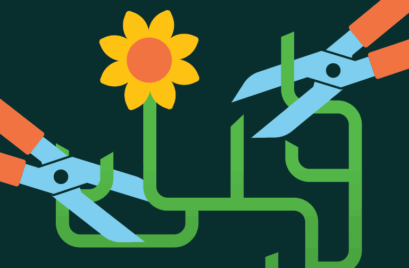
“Networking” can get a bad rap in the workplace. But humans have been connecting across groups, societies and cultures for as long as it’s been possible to do so. Networking with others is not just about finding that next job or getting a favour done, it’s about social connections, exchange of ideas, building influence and creating positive, systemic change. Embracing networking can be absolutely critical in unearthing new perspectives and encountering new ideas that stimulate creative and innovative thinking.
Getting Moving
Often, though, the power of our networks can be self-limited. That’s why we advocate for something called strategic networking. What do we mean by strategic networking? Strategic networking is about building relationships that bring novel ideas, insights, and information to expand our perspectives and enhance our thinking. These kind of diverse outlooks won’t come from the people we work with directly everyday, who are often swimming in the same circles as us. It generally comes from those more far-flung network ties in our orbit.
The good news is that these relationships don’t necessarily require large amounts of time or energy to maintain. We do, however, need to be conscious of the shape of our networks over time because there are predictable ‘tendencies’ that can get in the way and see us falling into the same old comfortable habits.
The Roadblocks
How we tend to build networks presents two challenges for us when it comes to strategic networking. These are:
- History (who we’ve worked with before)
One of the major predictors of who we connect with, go to or spend time with is simply people we are familiar with from previously working together. If you think about the people you might speak to outside your immediate team, it is not uncommon that your main connections are all people you have collaborated with before in one capacity or another (e.g., previous teammates). This means we are less likely to explore novel connections around us.
- Homophily (people that are like us)
The other major tendency is something called ”homophily”. In simple words, homophily means we like people who are like us. We tend to gravitate towards, connect with and become friends with people who are similar to us. And the consequences of this for networking can be significant – and detrimental.
If we are already feeling slightly uncomfortable at the thought of networking, our tendency will always be just to network with those who we already know or naturally connect with. But this course is not only self-limiting, it’s ineffective. It means our breadth of experience, understanding and ideas will be constricted to people who already often are thinking the same way and about the same things as us.
We can also imagine the many potential nefarious outcomes of these tendencies. It’s easy to see how this predisposition might lead to networks which are homogenous in terms of gender, race and other characteristics (the proverbial “Boys Club”).
The Road Forward
So, how do we overcome these tendencies and start building our own dynamic networks?
- Map your networks
Map out your current network and reflect on the ways it might be limited (e.g. by organisation, by profession, by diversity). In particular, you want to distinguish between your strong and weak ties. Your strong ties are your co-workers or other people you work with closely most of the time – they give a lot to you but also require a lot of energy. Your weak ties are people on your periphery who you might only interact with sporadically but who have a different set of information and experiences to you. The opportunity here is to invest in and cultivate your weak ties in a way that gives you broad coverage.
- Seek reciprocity
Consider: what can you offer your weak ties? How can you connect and enhance their network? By seeking, and offering, reciprocity in behaviour and generosity, you will build a stronger connection. Even just exchanging information about yourself supports in building trust. Regardless of who you want to connect with, demonstrating that you are genuinely interested in getting to know them is your most powerful weapon. As noted by the Forbes Coaches Council, “follow up is rare and follow through is nearly extinct.” A few small words here and there as a follow up will go a long way and continue to build the relationship between meetings. Following through, and helping them with something you said you would, will forge an enduring connection. Over time, we can build real social capital.
- Think through analogies
To get the most out of the information and insights that your weak ties share with you, you can harness the power of analogical thinking. Analogy enables us to transfer knowledge from one domain to another based on conceptual similarities and, in turn, access different ways of looking at a situation or problem. In business, this is often a source of powerful innovative thinking. For example, Toyota’s production system was inspired by the shelf-stocking procedures of US supermarkets. Working with people from different functional areas within your organisation is also a potential source of diverse and analogical thinking. Apple, for instance, brought together their design and marketing leaders to add to discussions led by the camera team on the design of portrait mode for the iPhone. Drawing in the insights of your weak ties, try and apply some of their frames of reference to what’s going on in your world.
Getting strategic about networking is not just about finding people to help you achieve your goals – it’s about putting a premium on connections which are diverse, dynamic and instructive. Taking the time to be purposeful about how and who you connect with can truly elevate yourself and your network.
Need More Help?
Keen to find out more about how strategic networking can unlock new possibilities in your personal and professional growth? Performance Frontiers work with organisations and their people to map out their current networks, identify limitations, seek out weak ties, think through analogies, offer reciprocity and support, and demonstrate genuine interest and follow through – ultimately empowering leaders to build enduring relationships. Speak to Chris about how we can unlock your networking potential today.
While every effort has been made to provide valuable, useful information in this publication, this organisation and any related suppliers or associated companies accept no responsibility or any form of liability from reliance upon or use of its contents. Any suggestions should be considered carefully within your own particular circumstances, as they are intended as general information only.








